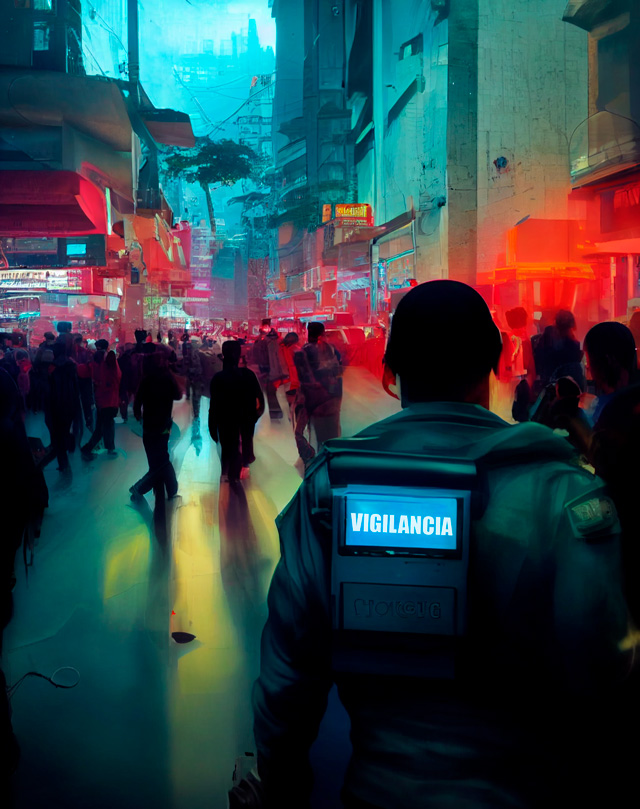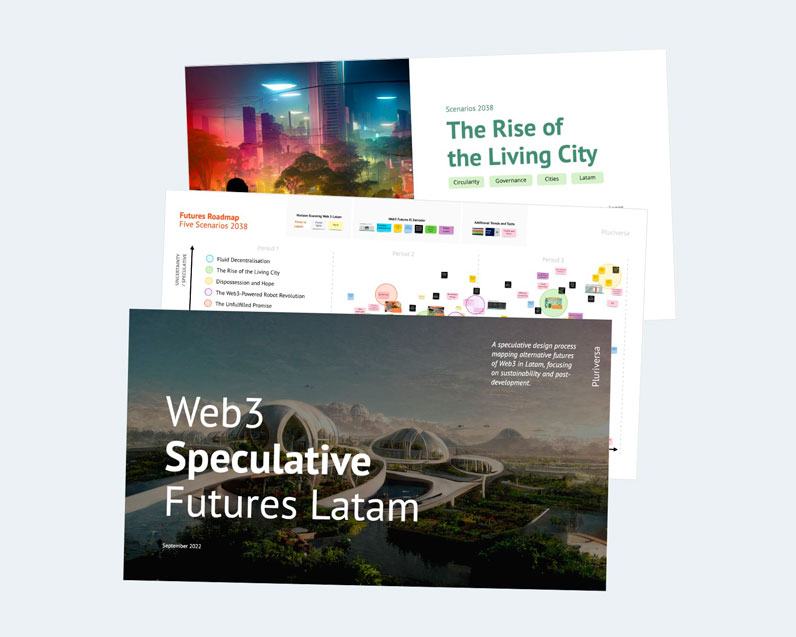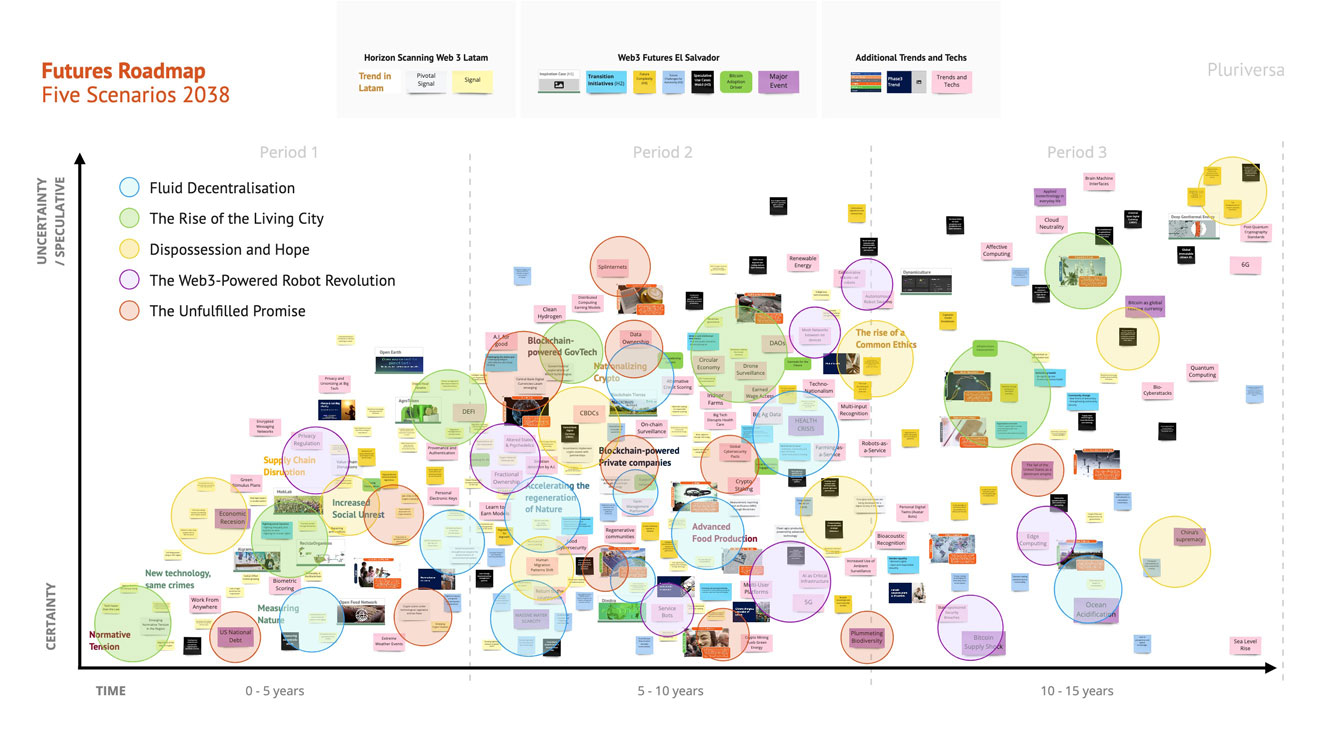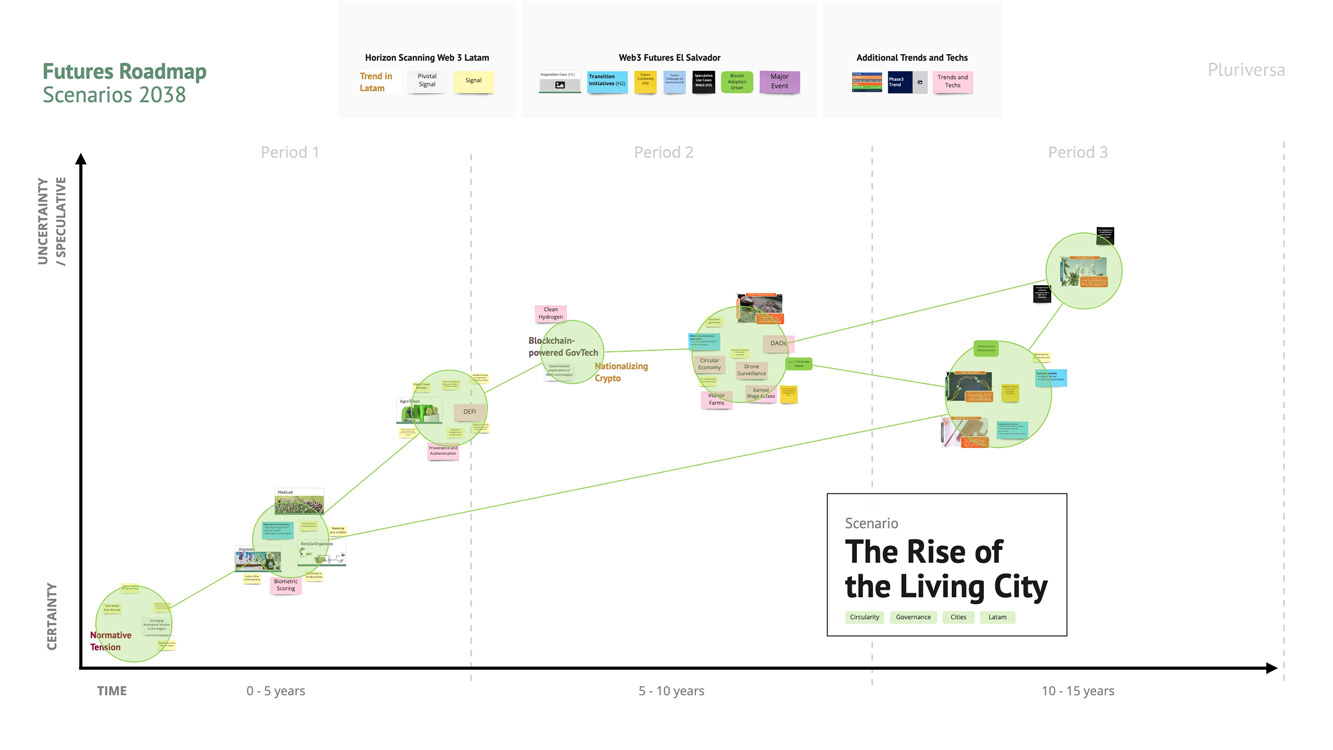Nuestros escenarios
El surgimiento de la ciudad viviente - 2038
Resumen del escenario
Las ciudades relacionales en América Latina están ayudando a enfrentar el cambio climático y a establecer una nueva forma de relacionarse con el entorno. Todo esto fue posible gracias a un contrato inteligente firmado en Lima por algunas de las megaciudades de la región. Estas megaciudades establecieron un protocolo de “prueba de circularidad”, alejándose de las economías lineales y avanzando hacia las circulares. Con la ayuda de la cooperación internacional, surgieron nuevas formas de gobernanza donde los ciudadanos tenían voz directa en asuntos locales importantes. De manera similar, nuevas formas de finanzas descentralizadas permitieron que las personas invirtieran en diferentes iniciativas, facilitando el florecimiento de los bienes comunes. Sin embargo, la implementación de tanta tecnología no está exenta de riesgos.
*Este escenario fue escrito originalmente en inglés británico.
Proyecto:
- Web3 Speculative Futures Latam
Sector:
Web3, Bitcoin, Blockchain
Temas clave:
Circularidad, Governanza, Ciudades, Latam
Año horizonte:
2038

La Ciudad Relacional y Convivencial
En América Latina se vive un auge de ciudades relacionales, es decir, urbes que no solo están enfrentando el cambio climático sino también generando sistemas que se relacionan con la vida y los ecosistemas existentes y pre-existentes de los territorios que hacen parte.
Este movimiento fue posible gracias al acuerdo sobre Ética Tecnológica y Ciudades Autónomas y Regenerativas en Lima, Perú, el cuál fue firmado como contrato inteligente en la Web3 y ratificado años después por 15 megaciudades en total.
Dicho acuerdo sentó los fundamentos para la transformación de las ciudades en verdaderos nichos donde la vida humana podría coexistir con la naturaleza en sistemas simbióticos con las bioregiones circundantes, y con tecnología de avanzada para la regeneración. La prioridad es el buen vivir, la autonomía de las comunidades, y la pluralidad de cosmovisiones de las gentes que poblaron las ciudades de manera masiva por las constantes migraciones internas y externas.
El auge de los gobiernos de izquierda progresista en la región dieron prioridad e incentivos para que las personas pudieran formar emprendimientos descentralizados para autoorganizarse y gestionar de manera local sus propios servicios, a la vez que se conectaban de manera inteligente con los sistemas centrales en mutua colaboración, transparencia y remuneración.

La Circularidad
Las 15 megaciudades dentro del acuerdo de Lima, no permiten la economía lineal, es decir, la producción de cualquier producto o servicio que no considere el desperdicio como parte de su cadena de valor.
Las compensaciones de carbono de las ciudades para cumplir los acuerdos ambientales internacionales consideran el aprovechamiento de los residuos y eliminan el concepto de “basura”. Se incorpora un protocolo blockchain de “proof-of-circularity”, en el que al generar energía y otros materiales aprovechables son registrados y pueden verificarse a nivel internacional, involucrando a los ciudadanos en el compostaje del material orgánico y la toma de decisiones bajo un mantra de cero desperdicios.
La digitalización del dinero, los contratos inteligentes, la inmutabilidad de la información en la blockchain, la inteligencia artificial y el internet de las cosas permitieron que estos complejos sistemas se entramaran de maneras intrincadas y ultraeficientes. Este es el inicio de una verdadera economía circular a escala.
La gobernanza tecnológica plural
A través de un esfuerzo coordinado entre cooperación internacional y gobiernos municipales se establecieron los primeros asentamientos autónomos en dónde los ciudadanos tenían voz y voto en las decisiones del bien común. Un grupo de activistas y techno-utopians desarrollaron los primeros Gobiernos Autónomos Ciudadanos Descentralizados (DAGovs) para la gobernanza de dichas comunidades suburbanas, y en las cuales los ciudadanos a través de una plataforma tecnológica no solo se comunican entre ellos y con otras localidades, sino también participan directamente en la toma de decisiones.
Dichos gobiernos ciudadanos funcionan con una democracia más representativa, participativa, directa y fluida, escogiendo a sus gobernantes en la misma plataforma y con un registro inmutable de sus propuestas y logros al final de cada periodo.
A su vez, dentro de las DAGovs se pueden organizar grupos de acción temáticos de diferente índole para sacar adelante proyectos conjuntos, con una licitación y selección de propuestas de manera pública y justa. Los contratos son vigilados por la ciudadanía y pueden ser auditados por cualquier ciudadano o persona en el mundo. Las ayudas internacionales fluyen directamente a los grupos temáticos que tienen potestad de la toma de decisiones bajo la demanda de las necesidades de la comunidad en general.
En un caso reciente, un grupo de acción temático en la DAGov de la ciudad de Sao Paulo, Brasil, propuso mejoras en el procedimiento de gestión de residuos de las baterías de los vehículos, la propuesta recibió aprobación comunitaria local, revisión de expertos en residuos tóxicos, y fondos internacionales para su implementación, todo en una única plataforma de la DAGov local.
Todo esto no hubiera sido posible sin la adopción de una economía tokenizada, respaldada por las distintas capas del protocolo Bitcoin, permitiendo experimentos vivos de gobernanza en los cuales los ciudadanos pueden tramitar sus credenciales, pagar impuestos y servicios, y tomar decisiones que afectan a sus localidades de manera inmediata, inmutable y transparente.

Finanzas para la transición
Otras plataformas de Finanzas Ciudadanas Descentralizadas (DeCiFis) permitieron que personas dentro y fuera de la ciudad pudieran invertir en los diferentes proyectos de energías limpias, transporte comunitario, aprovechamiento de basuras, construcción de oasis verdes públicos, reverdecimiento de edificios y cultivo de comida orgánica. Gracias a esta explosión de nuevos servicios con una inyección de capital mixto de impuestos y empresas aportantes, las ciudades generaron una gran cantidad de nuevos empleos llevando su bienestar a niveles nunca antes vistos.
Se crean modelos de tesorería comunitaria confiables y fondos de recursos automatizados, lo que permite el flujo de capital de forma eficiente y transparente, que se suman a los sistemas de gestión de claves criptográficas descentralizados, igualitarios y comunitarios. Así las DAGovs cuentan con derechos y permisos compartidos desglosables, que permiten distribuir fracciones de acceso entre los participantes, o monetizar subsegmentos de los roles de gobernanza.
Estos servicios son controlados por contratos inteligentes que distribuyen el capital en los diferentes niveles de inversionistas-participantes y fondos públicos de manera inmediata y transparente. Los viejos sistemas financieros centralizados ya no tienen el control total, ahora son actores más horizontales que brindan servicios a esta red distribuida según las decisiones de cada localidad a través de las DAGovs.
Así la economía de las ciudades fluye de forma que los ciudadanos invierten constante y libremente en los proyectos que más les interesan y que son propuestos por los grupos de acción temáticos dentro de cada DAGov.
La creciente capacidad de absorción de CO2 de estas nacientes ciudades verdes significa que la regeneración es beneficiosa para las finanzas y tesorería de las DAGovs, ya que otros actores contaminantes deben pagar para compensar sus propias emisiones a los actores que funcionan como una esponja de gases contaminantes.
La Sensorización de la Ciudad y el Control Verde
A través de la sensorización de la ciudad se ha logrado tener data real que fluye por la blockchain de manera pública. La revolución de la ciudad y el control a través de data ha puesto las megaciudades en un nivel de control ambiental nunca antes visto. De esta forma se pueden alertar de manera temprana altos niveles de dióxido de carbono, ruido, criminalidad, caudal del agua, así como también la interacción y el cuidado de especies que han empezado a convivir en la ciudad por medio de los oasis y los techos verdes.
Con tantos sensores en la ciudad, la ciberseguridad es una prioridad estratégica. Las 15 megaciudades firmantes del acuerdo fundan una unidad de investigación descentralizada, donde participan expertos locales y extranjeros, antiguos hackers, DAGovs y gobiernos municipales, para garantizar la implementación de más altos estándares en criptografía y ciberseguridad, y hacen contrainteligencia de potenciales ataques.
Las empresas también tienen que someterse a estrictos controles medioambientales y de ciberseguridad a través de sensores auditados por el gobierno y las DAGov. Estas mediciones alimentan contratos inteligentes de acceso público y hacen que cualquier persona pueda auditar las penalizaciones por los impactos medioambientales y las externalidades de las empresas.
La descentralización ha empezado a ganar tracción. Debido a la alta competitividad de las empresas descentralizadas con mejores garantías y derechos para los trabajadores, muchas corporaciones y multinacionales han empezado a migrar a modelos de co-ownership y co-governance.
La Coproducción
Otro principio ético en el que las ciudades se comprometieron fue la autonomía, en la cuál se quiere devolver la capacidad de producción de bienes y servicios a las personas de una comunidad y barrio. Las localidades que han votado por este programa, diseñado por cooperación internacional a través de las DAGovs, han instalado fábricas avanzadas con robótica y maquinaria de última generación dándole el poder a las personas de la localidad de producir ropa, accesorios para el hogar, sistemas energéticos, insumos para la agricultura urbana, mobiliario, entre otros elementos que fortalecen la creatividad y suplen las necesidades locales.
Este concepto trajo consigo la inversión masiva en talleres y fábricas locales, en Makerspaces y FabLabs, dónde la manufactura de los propios bienes se convierte en una forma de empleo y de construcción comunitaria. Los niveles de drogadicción, adicción, alcoholismo y violencia intrafamiliar rápidamente bajaron con la formulación de estos espacios barriales.

La Opresión
Las tensiones normativas dentro de cada megaciudad y el ascenso al poder de algunos gobiernos de derecha radical y autoritaria, han hecho que estos adelantos también sean cooptados por una élite opresora.
Tal es el caso de Ciudad de México, donde la vigilancia social por medio de la sensorización que fue instalada para el nacimiento de la ciudad viva, ahora se usa para la vigilancia dictatorial y el adoctrinamiento del comportamiento ciudadano por medio de scoring social en el cuál los ciudadanos son evaluados según sus acciones. Esta evaluación no es opcional, y es el aval para poder gozar de los servicios de la ciudad, de la libertad y de los instrumentos financieros, que a su vez son retroalimentados por el scoring y el historial comportamental.
No es claro cómo terminará este experimento en las megaciudades latinoamericanas, pero lo que es seguro es un notable avance en el relacionamiento y el respeto entre humanos y no humanos, en la recuperación de la vida silvestre y en la mitigación de los efectos más adversos del cambio climático.






